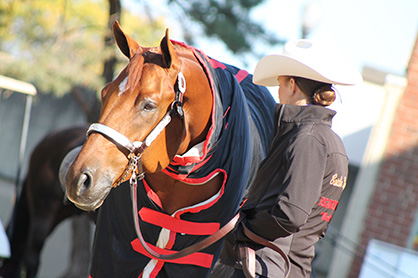Winter Weather- A Guide to Blanketing Horses

It’s Blanket Season!
By: Aimee Robinson
There is much to consider when selecting a blanket for your horse, including the horse’s age, body condition, and coat thickness, to name only a few aspects. Additionally, horses across the country experience a variety of climates, weather conditions, and stabling environments. Luckily, just as our closets hold clothes tailored to the day and season, there are different types of horse blankets available, too, so you can select just what your horse needs when he needs it.
The Basics
For horse owners to best determine what kind of blanket and heaviness their horse will need, let’s first look at a few horse blanketing basic terms, such as “sheets” vs. “blankets” and “turnout” vs. “stable.”
A horse sheet is lightweight and perfect for those mildly cold or windy days. They have no fill. A horse blanket, rather, offers fill, which is essentially a form of insulation sewn into the blanket to add warmth (think of your winter coat!) The higher the fill number on a blanket, the cozier the pony on those cold days.
Sheets and blankets come in two varieties: turnout and stable, for horses in either respective environment. Turnout sheets and turnout blankets feature waterproof material to keep pasture ponies dry. Without waterproof technology, a wet horse blanket could unintentionally make your horse colder. Stable sheets and stable blankets are ideal for stabled horses and therefore not made from waterproof material. They serve an important purpose by keeping stabled horses comfy, warm and sleek.
Warmth & Durability
When you are selecting a horse blanket, you will notice a few number sets under the product descriptions, noting “denier” and “fill.” Denier denotes the durability of a horse blanket or sheet. It measures nylon fiber density on the outer material of horse blankets. Denier ranges from 70 to 2400D. The higher the denier, the more durable it is for those tough-on-blanket horses (you might have one or two in mind!) As we shared earlier, fill is padding that adds an extra layer of warmth to your horse’s blanket. Both with denier and fill, the higher the number, the tougher or warmer the blanket’s material will be.
Do you know the degree of blanket warmth your horse may need and when? Refer to this easy-to-reference chart to help as a guide. But keep in mind, a 50° winter day will feel much different to a Miami horse vs. a Milwaukee horse, so blanket accordingly as needed.
Weather Conditions – Grams of Fill
50-60°- Sheet (0g)
40-50°- Light blanket (100g)
30-40°- Light or medium blanket (150 to 250g)
20-30°- Medium or heavy blanket (200 to 300g)
Below 20°- Heavy blanket (300 to 400g)
Sizing
When measuring your horse, start from the center of his chest and measure around the widest part of the shoulder, along the barrel, and around the widest part of the hindquarter to the center of the tail. Keep your line horizontal to the ground. His blanket measurement will be the same as the number of inches measured. If the exact number of inches is not available to select from, size up to the nearest measurement.
Storing & Cleaning Blankets
Help extend the life of your horse’s blankets and sheets by properly storing them on a rack or in a blanket storage bag. This will also help protect them from opportunistic rodents who may look at a new blanket as a home or snack.
Remember, after your horse’s blankets have protected them from the rain, snow and the muck of cold weather, it’s time for a good cleaning. You can either opt to clean blankets yourself, or you can send them to a blanket laundry service. Cleaning your horse’s blanket may be easier than you think! Just follow these steps.
- Pre-wash: Use a stiff brush to remove excess hair, mud and dirt. Hose off blanket, and hang to dry.
- Wash: Use a horse blanket detergent.
- Dry: Hang horse blankets to dry in a shady area to avoid color deterioration of the material. Follow the blanket manufacturer’s cleaning instructions for best results.
Ensure your horse’s comfort with a high-quality horse blanket or sheet that meets his specific needs. Visit ValleyVet.com for a broad selection of horse blankets, shipped Secretariat-fast to your barn door.
About Valley Vet Supply
Valley Vet Supply was founded in 1985 by veterinarians to provide customers with the very best animal health solutions. Building on over half a century of experience in veterinary medicine, Valley Vet Supply serves equine, pet and livestock owners with thousands of products and medications hand-selected by Valley Vet Supply founding veterinarians and their professional staff. With an in-house pharmacy that is licensed in all 50 states, and verified through the National Association of Boards of Pharmacy (NABP), Valley Vet Supply is the dedicated source for all things horse, livestock and pet. For more information, please visit ValleyVet.com.










